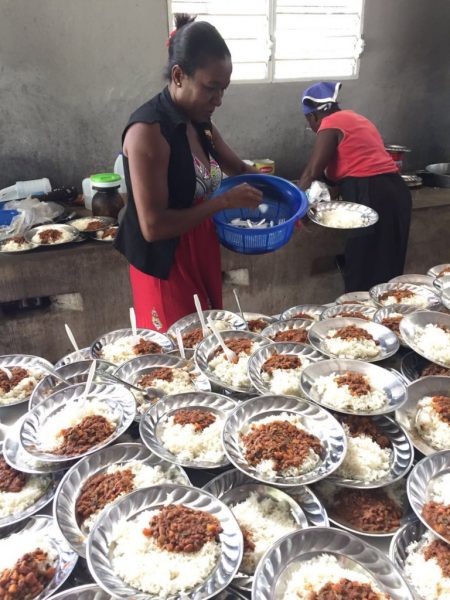Haiti Goat Project
The Venture
The Haiti Goat Project is a nonprofit organization whose primary mission is to improve child nutrition in Haiti. It accomplishes this in three ways: they provide meals of goat chili or “chili kabrit” in Haitian schools, they improve goat genetics within local herds, and they support economic growth by buying vegetables and by selling and buying goats to stimulate the local economy. This is Haiti Goat’s third year as a venture with the fellows.
The Journey
The Haiti Goat team started off with a lot of excitement and ideas. In order to narrow these down, they took full advantage of the information that the Haiti Goat Project NGO had collected over the previous years.

The team knew they wanted to help educate US audiences while still serving their audience in Haiti. After discussion and research, the main takeaways from their expertise in Haiti was that they needed to better communicate the value of chili kabrit and therefore the value of the project itself.
Upon consideration of how they could most effectively communicate value, the team decided their target audience in Haiti would be the school administration and the parents of the students. They then organized themselves to focus on three major focus areas which would be messaging content, visual content, and data and statistics.
To design the best content possible, the Haiti Goat team asked their partners in Haiti to conduct some user research with their target audience. The questions consisted of things like “How much money do you send with your child to school for lunch?” and “what would motivate you to want to purchase chili kibrit for your child?”
The Outcome
Equipped with this research and their own, the team created a communication tool kit with different content and messaging specifically targeting either US stakeholders or the audience in Haiti. They included language that can be appropriated and used in different contexts in the future as well as visual content with photos from Haiti, open source photos, and graphics and infographics that the team created.

They made sure to organize data and statistics with information on the region and the actual nutritional information on chili kabrit.
One major goal the team had in mind when creating their deliverables was the sustainability of this project. They wanted to ensure that it wouldn’t stand alone but that it would be something they could pass on to future SIF fellows and everyone who works at Haiti Goat Project to build on and continue using. They managed to accomplish that while still providing a thorough and much needed communication kit for their venture to use.
Lessons Learned
The team learned a lot this year about trust. They not only had to learn how to trust each other but really how to trust in the process. “It’s harder to get moving than we thought” said Leah Flanders, “but all the process is important.” Grace Herndon emphasized how important patience with process was when it came to “embracing the mess and the uncertainty of endless possibilities while trying to really maintain a scope throughout the project.”
Once that trust was built, the team’s biggest challenge and lesson was figuring out the real heart of their project. Grace again addressed one of their major takeaways describing the importance of understanding the bigger picture and then narrowing it down.
One lesson that is intrinsic to the program but which may surprise people is described by Victoria Fuda. She talks about how they “learned that what isn’t always the most important thing is having solutions.” If you are only focused on solutions, you will probably come up with bad ones. Instead, she said the team “learned that asking the right questions is often very beneficial and effective just because it leads you to unexpected places and different ideas that you never would have had in the first place.”
We loved hearing all of the amazing takeaways this team had and applaud their teamwork and effort. The Haiti Goat project is an incredible organization and working with them for the past three years has been incredible for all three of the SI Fellows teams they have partnered with.
The Team
- Grace Herndon, graduate student, graphic design
- Leah Flanders, sophomore, sustainable materials and technology
- Victoria Fuda, sophomore, environmental science
- Yashmitha Lenin, sophomore, exploratory studies
- Senior Fellow: Marcie Laird, graduate student, graphic design
- Team Mentor: Brian Speight, PE, Vice-President, Mott MacDonald
- Venture Partner: Dr. Char Farin, Professor, College of Agriculture and Life Sciences

